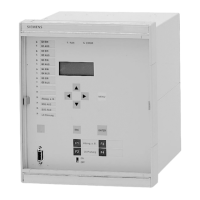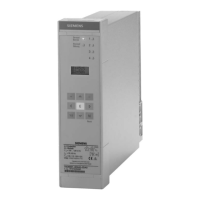Functions
2.5 Distance Protection
SIPROTEC, 7SD5, Manual
C53000-G1176-C169-5, Release date 02.2011
116
Negative Sequence Current 3I
2
>
On long, heavily loaded lines, large currents could cause excessive restraint of the earth current measurement
(ref. Figure 2-35). To ensure secure detection of earth faults in this case, a negative sequence comparison
stage is additionally provided. In the event of a single-phase fault, the negative sequence current I
2
has ap-
proximately the same magnitude as the zero sequence current I
0
. When the ratio zero sequence current / neg-
ative sequence current exceeds a preset ratio, this stage picks up. For this stage a parabolic characteristic pro-
vides restraint in the event of large negative sequence currents. Figure 2-36 illustrates this relationship. A
release by means of the negative sequence current comparison stage requires currents of at least 0.2·I
N
for
3I
0
and 3I
2
.
Figure 2-36 Characteristic of the I
0
/I
2
stage
Displacement Voltage 3U
0
For the neutral displacement voltage recognition the displacement voltage (3·U
0
) is numerically filtered and the
fundamental frequency is monitored to recognize whether it exceeds the set threshold. The dropout threshold
is approximately 95 % of the pickup threshold. In earthed systems (3U0> Threshold) it can be used as an
additional criterion for earth faults. For earthed systems, the U
0
–criterion may be disabled by applying the ∞
setting.
Logical Combination for Earthed Systems
The current and voltage criteria supplement each other, as the displacement voltage increases when the zero
sequence to positive sequence impedance ratio is large, whereas the earth current increases when the zero
sequence to positive sequence impedance ratio is smaller. Therefore, the current and voltage criteria for
earthed systems are normally ORed. However, the two criteria may also be ANDed (settable, see Figure 2-37).
Setting 3U0> Threshold to infinite makes this criterion ineffective.
If the device detects a current transformer saturation in any phase current, the voltage criterion is indeed crucial
to the detection of an earth fault since irregular current transformer saturation can cause a faulty secondary
zero-sequence current although no primary zero-sequence current is present.
If displacement voltage detection has been made ineffective by setting 3U0> Threshold to infinite, earth fault
detection with the current criterion is possible even if the current transformers are saturated.
The earth fault detection alone
does not cause a general fault detection of the distance protection, but merely
controls the further fault detection modules. It is only alarmed in case of a general fault detection.
